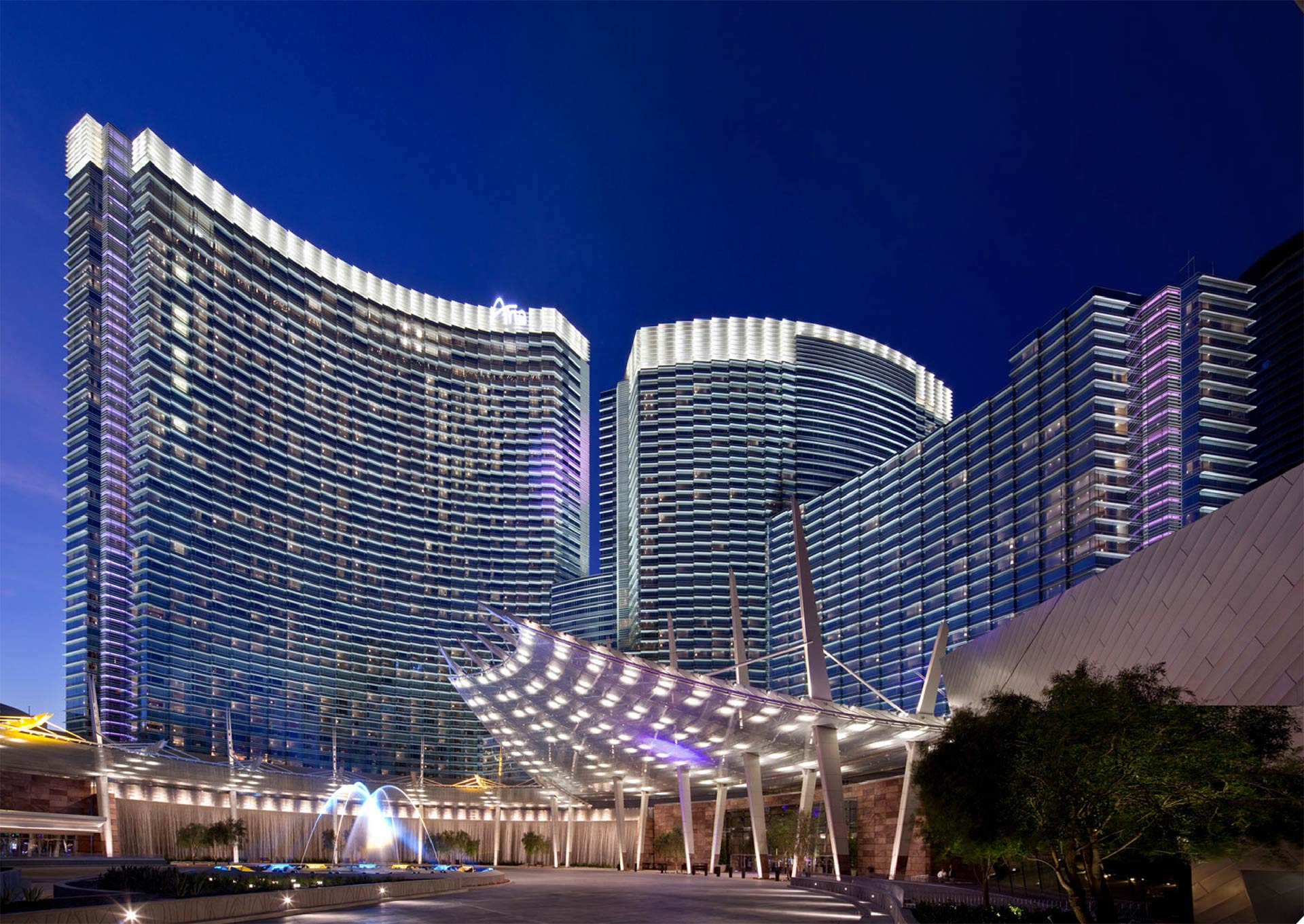Inspection Criteria and Standards
Viracon's insulating glass units are Insulating Glass Certification Council (IGCC) certified to ASTM E2190 Standard Specification for Insulating Glass Unit Performance and Evaluation.
Viracon's laminated glass units with a minimum .030" pvb interlayer comply with ANSI Z97.1 and CPSC 16 CFR 1201, which are the industry safety standards for glazing materials.
In addition, Viracon’s laminated glass units comply with ASTM C1172 Standard Specification for Laminated Architectural Flat Glass.
Edge Blushing
In both structural and butt glazed applications, silicone sealants may come in contact with the polyvinyl butyral (pvb) interlayer used in laminated glass. When silicone contacts the laminated glass edge, a cosmetic blushing of the pvb interlayer will occur over time. It generally begins as a small bubble formation at the contacted edge, which then grows to form a limited unbonded area at the glass edge. This reaction is limited and generally does not exceed more than 3/8" (9.5mm). Edge blushing may be visible however does not affect the structural integrity of the laminated glass with respect to its ability to resist uniform loads.
Viracon’s heat-treated glass products comply with ASTM Standard C1048 Standard Specification for Heat-Strengthened and Fully Tempered Flat Glass.
Quality Criteria
- Roller wave: The roller wave will not exceed 0.003″ (0.076mm) from peak to valley in the center of lites and a maximum of 0.008″ (0.20mm) within 11.3″ (287mm) of the leading or trailing edge.
- Millidiopter (mD): For clear or low-iron glass 1/4” to 3/8” thick without ceramic frit or ink, the maximum distortion, as measured by the Osprey, will be + or – 100 mD over 95% of the glass surface.
- Localized Warp: For rectangular glass, the localized warp will not exceed 1/32” (0.8mm) over any 12” (305mm) span. This is half of the ASTM C1048 requirement of 1/16” (1.6mm) over any 12” span (30mm).
- Overall Warp: The overall warp will not exceed the measurements in the ASTM C1048 table.
Viracon's coated glass products comply with ASTM Standard C1376 Standard Specification for Pyrolytic and Vacuum Deposition Coatings on Flat Glass.
Inspection Guidelines
Inspect glass from a distance of 10 ft. (3m) in transmission, at a viewing angle of 90◦ to the specimen, against a bright, uniform background.
Quality Criteria
- Pinholes: If a pinhole is readily apparent when following the inspection guidelines, the following criteria apply: Pinholes larger than 1/16" (1.6mm) in diameter are not allowed in 80 percent of the central glass area. Pinholes larger than 3/32" (2.4mm) are not allowed in the outer 20 percent of the glass area. No more than two readily apparent blemishes are allowed in a 3" (75mm) diameter circle and no more than five readily apparent blemishes are allowed in a 12" (300mm) diameter circle.
- Uniformity: When viewing coated glass using the inspection guidelines of 10 ft. (3m), color variation may occur from one unit to another. This can be caused by variations within the float glass substrate and normal production variations, and this is not a defect. All Viracon commercial glass products conform to industry color standards.
- Distortion: Various factors involved in heat processing, insulating spacer placement and frame binding may distort reflected objects viewed on the glass surface. These are not defects of the coated glass or the final fabricated product.
- Scratches: Inspect glass per the inspection guidelines. Scratches up to 2" (50mm) are allowed in the central 80 percent of the glass area, and scratches up to 3" (75mm) are allowed in the outer area. Concentrated scratches or abraded areas are not allowed.
External Inspection and Quality Guidelines - DigitalDistinctions™
Viracon’s DigitalDistinctions printed glass products comply with ASTM C1048 Standard Specification for Heat Strengthened and Fully Tempered Flat Glass – Kind HS, Kind FT Coated and Uncoated, Condition B.
Inspection Guidelines
View DigitalDistinctions from a distance of 10 ft. (3m). Glass shall be viewed by light reflected from the outside facing surface (as installed), against a uniformly opaque backdrop material and in a vertical position.
DigitalDistinctions glass with less than 60% coverage shall be inspected from 10 ft. (3 m) in transmission; glass with 60% or more coverage in any one square foot area will follow spandrel inspection criteria.
Quality Criteria
Variations in perceived color may occur with any ceramic ink and will be more apparent with white or light colors because of unavoidable light transmission. Due to the inherent variations in ceramic ink thickness, light colors are more readily influenced by the colors of the materials installed behind the glass. Viracon takes no responsibility for variations in color or thickness that are within quality standards.
When viewing DigitalDistinctions in accordance with the inspection guidelines, pinholes, fisheyes, color concentrations, printing process streaks, paint particles and visible transitions in graduated patterns are not defects.
- Pattern/Image Orientation: Patterns or images may be located up to 1/16" (1.6mm) off parallel from the locating glass edge. Patterns or images may be up to 1/8" (3mm) off parallel from edges other than the locating glass edge.
- Pattern/Image Definition: An indefinite border of up to 1/32" (0.8mm) is acceptable.For DigitalDistinctions Dual Image, the dot axis centers may be slightly misaligned, regardless of the dot diameters. The darker colored dot will be slightly larger in diameter than the lighter colored dot.
- Pattern/Image Location: Variation of +/-1/32" (0.8mm) in pattern or image location is acceptable.
- Printing to Edge of Glass: There may be a 2mm nominal clear, enamel-free border around all edges for glass without a coating.DigitalDistinctions in combination with a Low-E coating, requires a minimum 3/8” (9.525mm) clear, enamel-free border around all edges. Some products require a wider enamel-free border, contact Viracon for details.
- Condensation Formation: Spandrel cavities may be prone to condensation formation on the glass surface exposed to the cavity. Over time, this may result in a visible film formation, especially when the DigitalDistinctions print is translucent. This is not a defect. When a translucent DigitalDistinctions print is utilized in a spandrel application; we recommend applying DigitalDistinctions to a surface not exposed to the spandrel cavity.
External Inspection and Quality Guidelines – Silk-screen and Digital Prime Print Processes
Products comply with ASTM C1048 Standard Specification for Heat Strengthened and Fully Tempered Flat Glass – Kind HS, Kind FT Coated and Uncoated, Condition B.
Inspection Guidelines
View glass from a distance of 10 ft. (3m). Glass shall be viewed by light reflected from the outside facing surface (as installed), against a uniformly opaque backup material and in a vertical position. Printed glass with patterns less than 60% coverage will be inspected from 10 ft. (3 m) in transmission; glass with patterns 60% or more coverage will follow spandrel inspection criteria.
Quality Criteria
Pinholes larger than 1/16” (1.6mm) are not allowed if noticeable from a distance of 10 ft. or greater. Color as well as opacity of the ceramic frit may vary slightly due to paint thickness variations.
- Pattern Orientation: Patterns may be located up to 1/16” (1.6mm) off parallel from the locating glass edge. Due to glass dimensions and squareness tolerances, patterns may be up to 1/8” (3mm) off parallel from edges other than the locating glass edge.
- Pattern Definition: Print definition of 1/32” (0.8mm) indefinite border is acceptable.
- Pattern Location: Variation of +/- 1/32” (0.8mm) in dot, line or hole location is acceptable.
- Printing to Edge of Glass: Printed Glass with Low-E coating is printed to the edge of the glass, coated and then the coating is edge deleted.
- Full Coverage Translucent Silk-screen:
- Pinholes to 1/16” diameter, fisheyes, streaks from screening process and paint particles are allowed. Large clusters of close spacing of pinholes or other defects are not allowed in the central 80% of the glass area.
- Spandrel cavities may be prone to condensation formation on the glass surface exposed to the cavity. Over time, this may result in a visible film formation. This is not a defect. When a translucent ceramic enamel color is utilized in a spandrel application, we recommend applying the frit to a surface not exposed to the spandrel cavity.
Viracon’s spandrel glass products comply with ASTM C1048 Standard Specification for Heat Strengthened and Fully Tempered Flat Glass – Kind HS, Kind FT Coated and Uncoated, Condition B.
Inspection Guidelines
View spandrel glass from a distance of 15 ft. (4.6m) under natural daylight conditions. Color and reflectance may vary when viewed under a uniform, opaque background. This is not a defect.
When viewing spandrel glass under similar conditions, reflected pinholes and scratches are not defects if they are unobtrusive.
In structurally glazed applications, a clear edge may be visible. Contact Viracon for more information.
Viracon reserves the right to change substrate glass suppliers. As a result, this may affect perceived colors of our Viraspan samples. Approval of all glass colors is based on 12" x 12" (305 mm x 305 mm) samples, which are ordered for each project.


